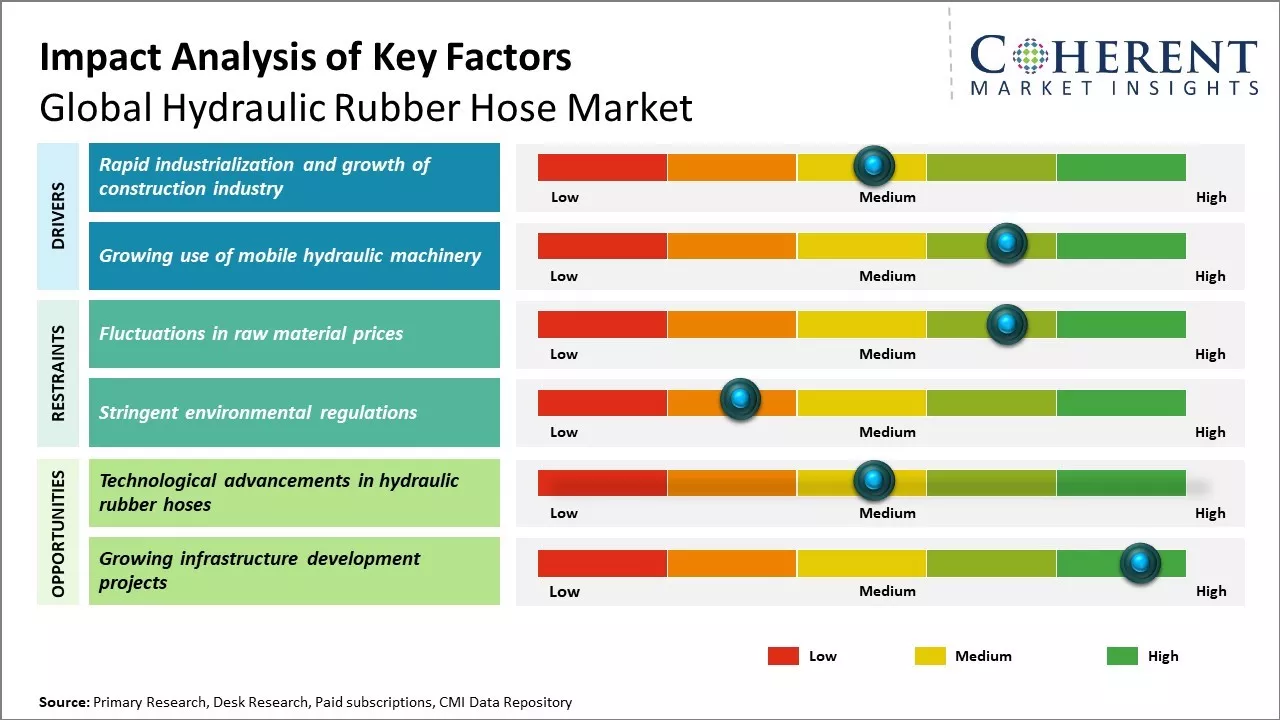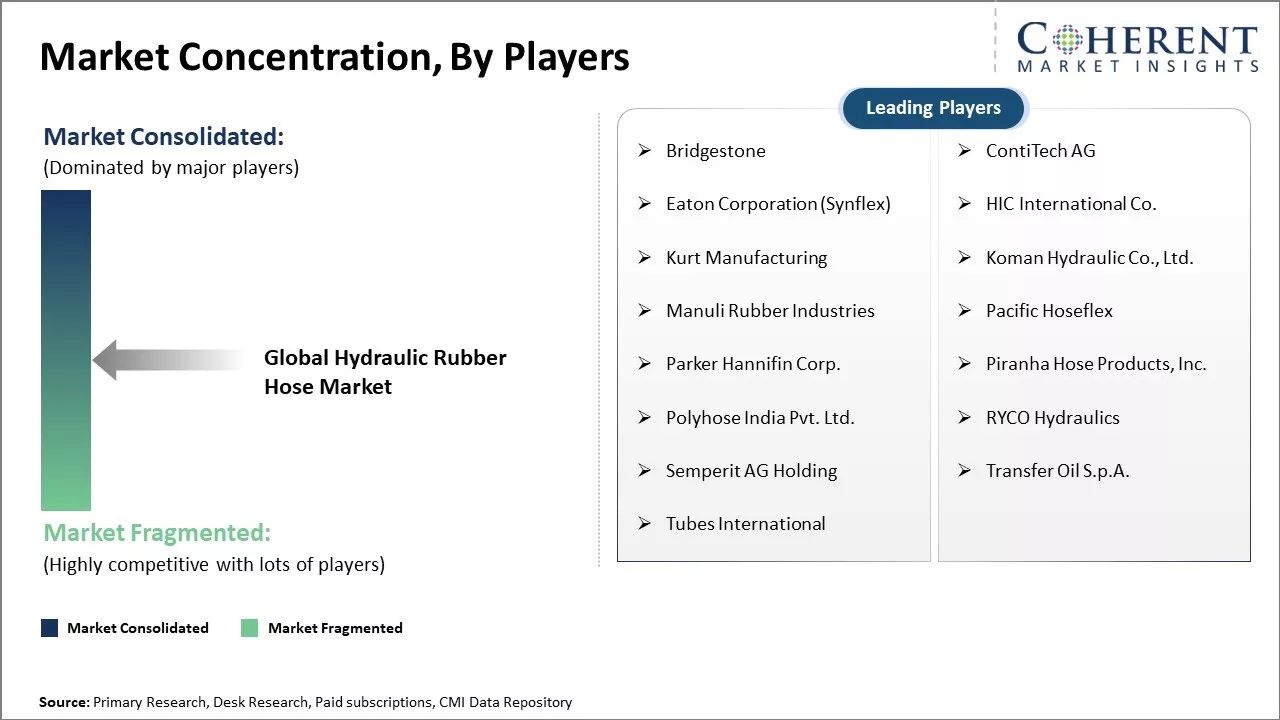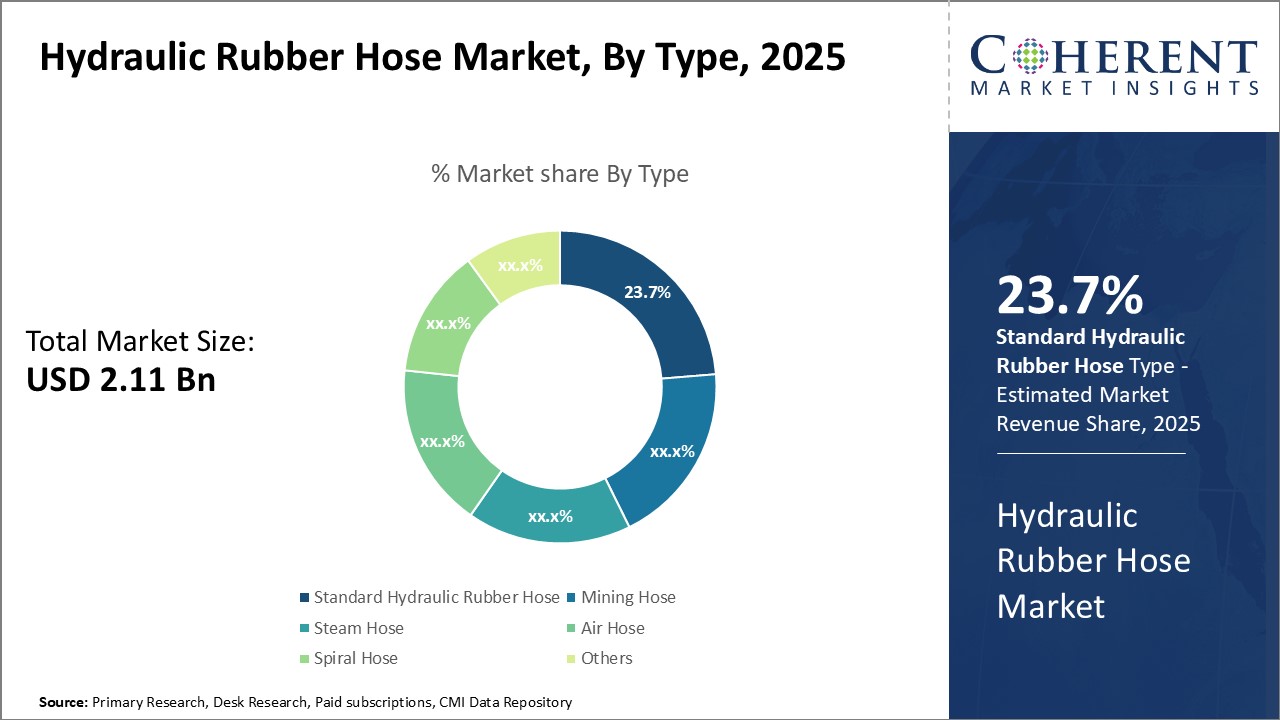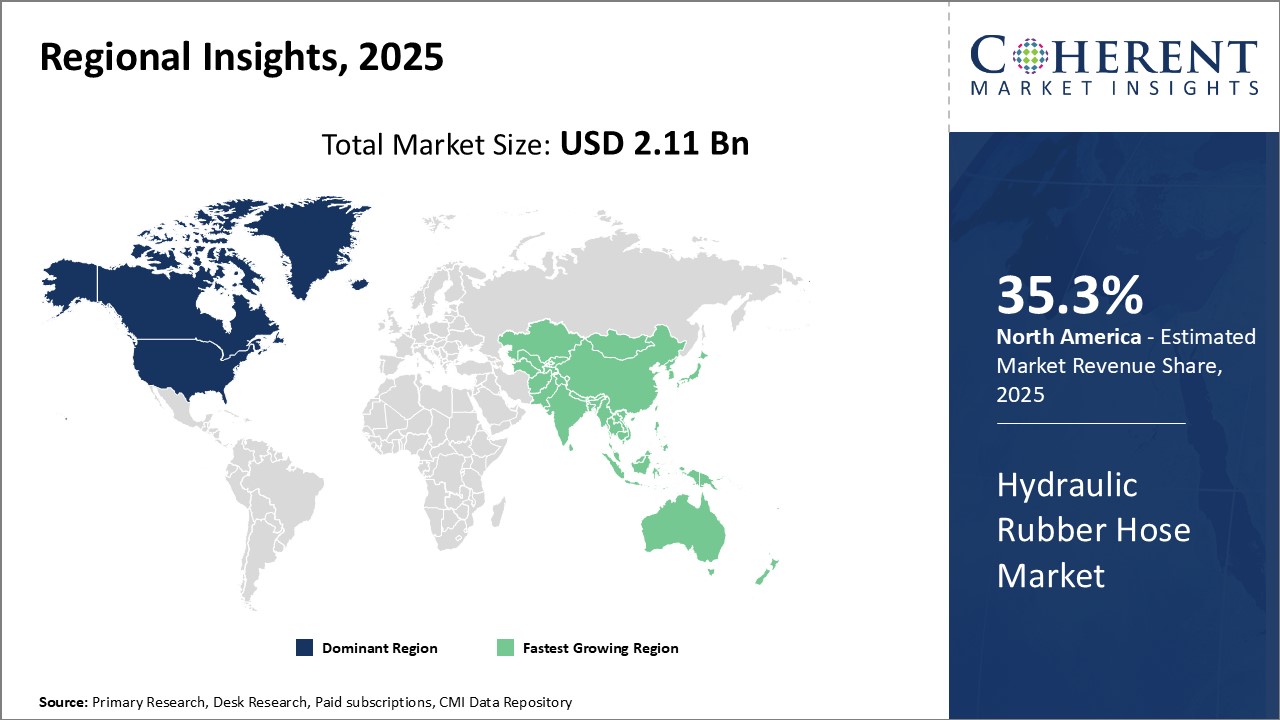The Global Hydraulic Rubber Hose Market is estimated to be valued at US$ 2.11 Bn in 2025 and is expected to reach US$ 3.33 Bn by 2032, exhibiting a compound annual growth rate (CAGR) of 6.7% from 2025 to 2032.

Discover market dynamics shaping the industry: Download Free Sample
Rapid industrialization and increased infrastructural development activities across major economies are some of the key factors driving demand for hydraulic rubber hoses in various construction equipment and machines. Growth in agriculture and mining industries coupled with expansion of oil & gas sector has further propelled the need for hydraulic systems using specialty hoses. Significant investments by leading manufacturers in product innovation to make hoses lighter, more durable and efficient for performance critical applications is expected to open new avenues for the market. However, the availability of substitute materials may limit the global hydraulic rubber hose market growth to a certain extent over the forecast period.
Rapid industrialization and growth of construction industry
With rapid industrialization taking place across regions, there is growing demand for hydraulic machines, construction equipment, and material handling equipment, agricultural machinery and other heavy industrial machineries. Hydraulic rubber hoses are extensively used in these machineries as flexible conduits to transmit pressurized fluids like oil and other hydraulic fluids. The robust growth of manufacturing and industrial sector in emerging economies is propelling the demand for complex and advanced machinery where hydraulic rubber hoses have widespread applications.
In addition, the construction industry worldwide has been witnessing significant expansion supported by rising infrastructural investments by various governments. Mega construction projects in areas of roads, bridges, commercial buildings, power plants, etc. rely heavily on construction equipment that uses hydraulics for efficient functioning. Whether it is earthmoving machinery, cranes, bulldozers or lifting platforms, they all require durable and flexible hydraulic hoses to effectively channel hydraulic fluid throughout the system. The booming construction activities have accelerated the procurement of modern construction machines, thereby generating ongoing requirement for hydraulic rubber hoses.

Get actionable strategies to beat competition: Download Free Sample
Growing use of mobile hydraulic machinery
In the recent times, there has been a visible shift towards greater mobilization of hydraulic machinery across multiple industries. Mobile cranes, aerial platforms, fork-lifts, truck-mounted concrete pumps and other compact hydraulic machinery have become ubiquitous on project sites as well as industrial facilities. Their maneuverability and flexible deployment have widened their application scope. However, being mobile machinery, they require hydraulic hoses that can withstand vibration, abrasion and withstand repeated flexing without compromising the fluid pressure. Here again, hydraulic rubber hoses have emerged as the material of choice owing to their superior mechanical, physical, and chemical properties. Similarly, sectors like agriculture, mining, material handling, etc. where off-road mobile machinery finds extensive utilization are significant end users. The proliferation of compact but powerful mobile hydraulic machinery is creating sustained demand momentum for hydraulic rubber hoses.
Key Takeaways from Analyst:
North America currently dominates the market aided by strong economic growth and rising investments in industrial and infrastructure projects. Asia Pacific and Europe are also notable markets owing to well-established end-use industries.
However, fluctuations in raw material prices pose a challenge to market players and can impact the supply of hydraulic rubber hoses. Stringent regulations pertaining to toxicity of materials may restrict the usage of certain types of hoses. The market is highly consolidated with a few global players competing for major market share. New product development and expansion into emerging economies present key opportunities for manufacturers to gain competitive advantage. Innovation in material and design of hoses to withstand high pressure and tough working conditions will be critical for propelling future growth.
Overall, the hydraulic rubber hose market outlook remains positive driven by rising off-highway vehicle sales and ongoing construction activities worldwide. Leading regional markets are expected to augment demand while growth in developing economies will open new avenues. Meanwhile, companies need to address challenges around raw material costs and regulatory issues to sustain long.
Market Challenges: Fluctuations in raw material prices
Fluctuations in the prices of raw materials have emerged as a significant challenge restraining the growth of the global hydraulic rubber hose market. Hydraulic rubber hoses are primarily made up of synthetic rubber along with other components like reinforcement materials, coverings, and liners. The prices of synthetic rubber, which constitutes a major portion of hydraulic hoses, have witnessed frequent fluctuations in recent times due to unstable costs of crude oil and natural gas.
Synthetic rubber is derived from petrochemical feedstock obtained from crude oil and natural gas. The prices of crude oil and natural gas are highly volatile and depend on several unpredictable geopolitical and economic factors across the world.
These fluctuations in petrochemical feedstock costs directly translate to instability in synthetic rubber prices required for hydraulic hose manufacturing. Frequent and abrupt price swings of key raw materials make it difficult for hose producers to maintain stable production costs. It also poses challenges for accurate cost forecasting and disruption in long-term business planning. Such raw material price risks discourage hydraulic hose companies from aggressively scaling up operations and investments needed to drive market growth. Stable raw material costs are crucial for the hydraulic hose industry to sustain profitable growth over the long run.
Market Opportunities: Technological advancements in hydraulic rubber hoses
Technological advancements are opening up new avenues of growth for the global hydraulic rubber hose market. Traditionally, hydraulic rubber hoses were simply tubes meant for transferring hydraulic fluids under pressure. However, the latest innovations allow hoses to do much more. Several manufacturers are developing 'smart hydraulic hoses' integrated with sensors to monitor pressure, temperature and vibration in real-time. This provides valuable operational insights to end users to optimize performance and prevent breakdowns. For example, agricultural equipment can adjust power based on readings from hoses. Similarly, construction vehicles get alerts on potential hydraulic system issues, improving safety.
Another key area seeing progress is material science. Researchers are designing hoses with enhanced protective layers and reinforcement fibers for reliability in harsh environments. Some hoses now feature multiple braided jackets woven with heat-resistant aramid fibers enabling use in heavy duty mining and oil & gas applications handled extreme heat and pressure fluctuations.
Going forward, the integration of IoT and data analytics promises to transform the hydraulics industry. 'Connected hoses' will automate maintenance and optimize performance via remote monitoring. This could help reduce downtime and costs for many sectors substantially. Clearly, technological innovations are opening new dimensions of usage while improving product capabilities. If successfully commercialized, these advancements will accelerate the hydraulic rubber hose market's growth trajectory in the post-pandemic era.

Discover high revenue pocket segments and roadmap to it: Download Free Sample
Insights By Type - Reliability drives demand for standard hydraulic rubber hoses
In terms of type, standard hydraulic rubber hose segment is expected to hold 23.7% share of the market in 2025 owing to its reliability and versatility. Standard hydraulic rubber hoses are designed to withstand extremely high pressures and temperatures, making them suitable for a wide range of industrial applications. Their reinforced construction with outer coverings like polyester or nylon braiding ensures long-lasting performance even in demanding conditions. As modern machinery grows in complexity, the need for reliable hoses that can operate seamlessly has increased significantly. Standard hoses fulfill this need with their consistent high quality that delivers minimal failure rates. Moreover, they are cost-effective and easily available off the shelves, allowing for quick replacement of damaged parts. Their universal dimensions also provide interchangeability that simplifies inventory and spare parts management for equipment owners. With industrial activity booming across sectors, standard hoses see broad use due to their reputation as the backbone of safe and efficient hydraulics operations.
Insights By Pressure - Medium pressure applications drive growth
In terms of pressure, the medium pressure segment is expected to hold 41.9% share of the market in 2025 as these hoses effectively meet the needs of diverse industrial processes. Medium pressure hoses, capable of withstanding pressures between 300-700 bars, are suited to a wide ambit of applications that involve tasks like transportation of fluids, power steering and braking mechanisms. Their flexibility allows use in applications with frequent bending cycles like conveyor belts and construction machinery. As manufacturing activity rises globally, production lines increasingly utilize automated equipment that employ hydraulics for precision material handling, assembly and other medium-pressure functions. Simultaneously, agricultural and construction industries continue modernizing their fleets with advanced hydraulically-powered machinery. Both trends significantly increase the volume of medium pressure hoses deployed across sectors.
Insights By Application - Growth in agricultural machinery boosts hose demand
In terms of application, agriculture and construction machinery segment is expected to hold 40.1% share of the market in 2025 driven by the increasing mechanization of these industries. In agriculture, the development of sophisticated equipment like tractors and harvesters has substantially boosted yields. Modern farm vehicles rely on hydraulic systems for power-assisted steering and precise implement controls. Similarly, the construction industry is witnessing rapid uptake of hydraulic excavators, loaders, dozers and cranes for infrastructure projects. Their complex movements and heavy lifting functions depend wholly on robust hydraulic hoses. Moreover, stringent emission regulations have accelerated the replacement of old machinery with new energy-efficient models that deploy advanced hydraulics. As agricultural and construction activity expands globally to meet rising demands, consumption of hoses tailored for heavy duty machinery applications grows accordingly.

Need a Different Region or Segment? Download Free Sample
North America has established itself as the dominant region in the global hydraulic rubber hose market. The region is expected to account for 35.3% of the market share in 2025. The region is home to several industry heavyweights that have been operating in the sector for decades. With a well-developed industrial infrastructure and manufacturing industry, the demand for hydraulic rubber hoses has always remained high from sectors like construction, mining, agriculture, and automobiles. Several OEMs have their production and manufacturing facilities located within the region, further driving the local demand.
The presence of leading hose manufacturers such as Parker Hannifin, Eaton, Gates, and Freudenberg has also cemented North America's position as a key exporter of hydraulic hoses. Their widespread distribution network helps cater to the demand from international markets like Europe and Asia Pacific. Meanwhile, the regional expertise in material science and cable engineering has allowed manufacturers to consistently innovate and launch premium hoses. This has ensured North American hoses can command a price premium in the export markets.
The Asia Pacific region has emerged as the fastest growing market for hydraulic rubber hoses. Rapid industrialization and infrastructure growth across developing countries like China, India, Indonesia, and Vietnam have majorly contributed to the rising hydraulic equipment consumption. With increasing foreign investments and local manufacturing, sectors utilizing hydraulic technology have witnessed strong expansion. This has opened up new growth avenues for hose suppliers.
Simultaneously, several global hose manufacturers have established manufacturing bases within Asia to take advantage of low costs and tap into the fast-growing demand. Localization efforts have helped improve affordability of hoses. The free trade agreements within the region have also enabled greater cross-border trade, meeting regional demand through intra-Asia supply. The abundant availability of raw materials and a large talent pool support the ongoing manufacturing shift and rising exports. These factors are expected to help Asia Pacific maintain its tag as the fastest expanding hydraulic rubber hose market globally.
Hydraulic Rubber Hose Market Report Coverage
| Report Coverage | Details | ||
|---|---|---|---|
| Base Year: | 2024 | Market Size in 2025: | USD 2.11 Bn |
| Historical Data for: | 2020 To 2024 | Forecast Period: | 2025 To 2032 |
| Forecast Period 2025 to 2032 CAGR: | 6.7% | 2032 Value Projection: | USD 3.33 Bn |
| Geographies covered: |
|
||
| Segments covered: |
|
||
| Companies covered: |
Bridgestone, ContiTech AG, Eaton Corporation (Synflex), HIC International Co., Kurt Manufacturing, Koman Hydraulic Co., Ltd., Manuli Rubber Industries, Pacific Hoseflex, Parker Hannifin Corp., Piranha Hose Products, Inc., Polyhose India Pvt. Ltd., RYCO Hydraulics, Semperit AG Holding, Transfer Oil S.p.A., and Tubes International |
||
| Growth Drivers: |
|
||
| Restraints & Challenges: |
|
||
Uncover macros and micros vetted on 75+ parameters: Get instant access to report
*Definition: The global hydraulic rubber hose market consists of companies that manufacture and sell reinforced rubber hoses used to transfer hydraulic fluids in machinery and construction equipment. Hydraulic rubber hoses are flexible rubber tubes reinforced with steel or synthetic fibers and designed to withstand extreme pressure variations and withstand abrasions from the hydraulic fluid flow and external conditions. They are found in hydraulic systems that power presses, cranes, excavators, bulldozers, farm equipment, and other industrial machinery requiring the transmission of hydraulic power.
Share
Share
About Author
Ankur Rai is a Research Consultant with over 5 years of experience in handling consulting and syndicated reports across diverse sectors. He manages consulting and market research projects centered on go-to-market strategy, opportunity analysis, competitive landscape, and market size estimation and forecasting. He also advises clients on identifying and targeting absolute opportunities to penetrate untapped markets.
Missing comfort of reading report in your local language? Find your preferred language :
Transform your Strategy with Exclusive Trending Reports :
Frequently Asked Questions
Joining thousands of companies around the world committed to making the Excellent Business Solutions.
View All Our Clients